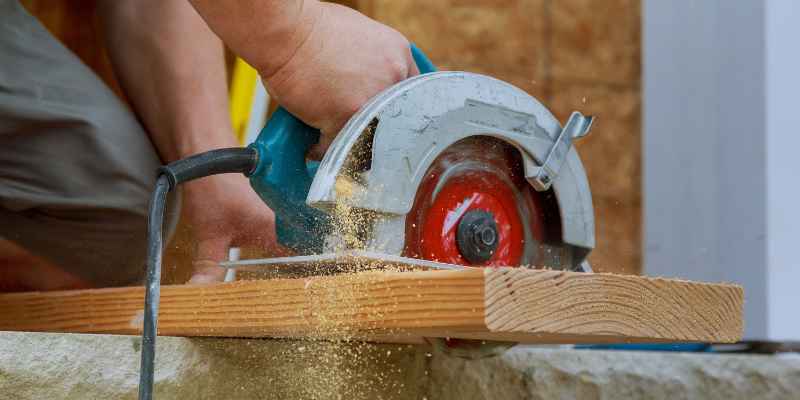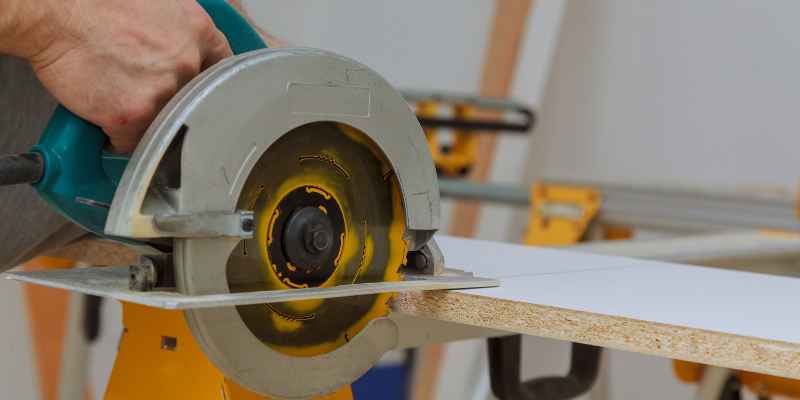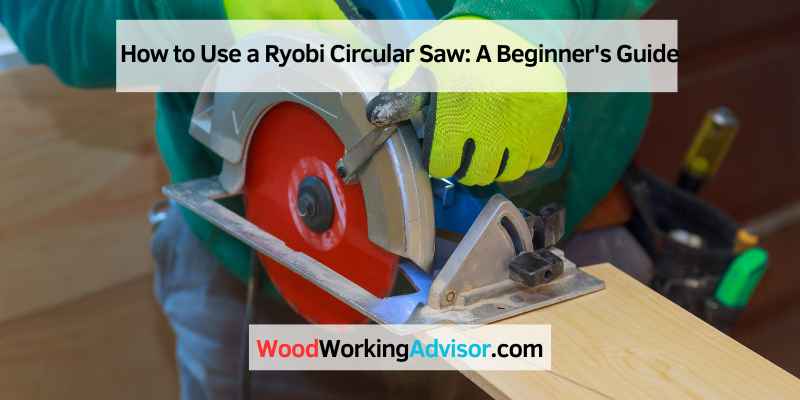To use a Ryobi Circular Saw, first, ensure the saw is unplugged and the blade is securely tightened. Then, position the material to be cut on a stable surface and mark the desired cut line.
Align the blade with the cut line and firmly hold the saw’s handle with both hands. Next, press the safety button and squeeze the trigger to start the saw. Gradually guide the saw along the cut line, applying steady pressure.
Remember to wear protective gear and keep your fingers away from the blade. Finally, release the trigger and wait for the blade to stop spinning before setting the saw down.
Introduction To Ryobi Circular Saws
Discover the versatility of Ryobi Circular Saws and learn how to effectively use them for your cutting needs. Gain insights on the proper techniques and safety precautions to maximize your tool’s performance.
If you’re in the market for a reliable, easy-to-use circular saw, Ryobi is a great brand to consider. Ryobi is a reputable tool manufacturer that has been around for over 75 years. They specialize in creating high-quality power tools, including circular saws, that are both affordable and easy to use. In this section, we’ll take a look at the brand history and reputation of Ryobi, as well as the basic features of their circular saws.
Brand History And Reputation
Ryobi was founded in Japan in 1943 and has since expanded its operations to become a global brand. Ryobi’s tools are known for their durability, reliability, and affordability. The company prides itself on developing innovative tools that are easy to use for both beginners and professionals. Ryobi has also won numerous awards for its innovative designs and commitment to quality.
Basic Features Of Ryobi Circular Saws
Ryobi circular saws are designed with the user in mind. They are lightweight, durable, and easy to use. Here are some of the basic features of Ryobi circular saws:
- Blade size: Ryobi circular saws come in a variety of blade sizes, including 5-1/2″, 6-1/2″, and 7-1/4″.
- Motor power: Ryobi circular saws typically have motors that range from 12 amps to 15 amps, providing plenty of power for most cutting jobs.
- Bevel capacity: Most Ryobi circular saws have a bevel capacity of 0-56 degrees, which allows for a wide range of cutting angles.
- Laser guide: Some Ryobi circular saws come with a laser guide, which helps to ensure accurate cuts.
- Dust port: Many Ryobi circular saws have a dust port that can be connected to a vacuum, helping to keep your workspace clean.
Overall, Ryobi circular saws are a great choice for anyone in need of a reliable, easy-to-use saw. With their innovative designs and commitment to quality, it’s no wonder that Ryobi is such a popular brand among DIYers and professionals alike.

Safety First
When using a Ryobi Circular Saw, prioritize safety first. Wear protective gear, secure your workpiece, and ensure a stable stance to prevent accidents. Always follow the manufacturer’s instructions for safe and proper usage.
Personal Protective Equipment
When it comes to using a Ryobi circular saw, safety should always be your top priority. One of the most important aspects of safety is wearing personal protective equipment (PPE). Before you start using your saw, make sure you have the following PPE:
- Safety glasses or goggles
- Hearing protection
- Gloves
- Long-sleeved shirt
- Pants
- Steel-toed shoes or boots
Understanding The Safety Features
In addition to wearing PPE, it’s important to understand the safety features of your Ryobi circular saw. Most saws come with features such as blade guards, blade brakes, and safety switches. Make sure you familiarize yourself with these features before using your saw.
Using The Saw Safely
Once you have your PPE and understand the safety features of your saw, you can begin using it safely. Here are some tips to keep in mind:
- Make sure the blade is properly tightened and aligned before use.
- Always use both hands to hold the saw.
- Keep your hands and fingers away from the blade.
- Never force the saw through the material you’re cutting.
- Make sure the saw has come to a complete stop before setting it down.
Remember, using a Ryobi circular saw can be dangerous if you don’t take the proper safety precautions. By wearing PPE, understanding the safety features of your saw, and following safe usage guidelines, you can ensure a safe and successful cutting experience.
Preparing Your Workspace
Before you start using your Ryobi Circular Saw, it’s important to prepare your workspace properly. This will ensure your safety and efficiency while operating the saw. In this section, we will cover the necessary steps to prepare your workspace for using the Ryobi Circular Saw.
Choosing A Stable Surface
When it comes to using a circular saw, choosing a stable surface is crucial. The stability of your workspace directly affects the accuracy and safety of your cuts. To ensure stability:
- Place the saw on a flat and level surface, such as a workbench or sawhorse.
- Ensure that the surface is sturdy and can support the weight of the saw and the material you will be cutting.
- Use clamps to secure the material you are cutting, preventing it from moving or shifting during operation.
Clearing The Area Of Hazards
Prior to using the Ryobi Circular Saw, it is essential to clear the area of any potential hazards. This will create a safe working environment and reduce the risk of accidents or injuries. Follow these guidelines to clear the area:
- Remove any clutter or debris that may obstruct your movement or interfere with the operation of the saw.
- Ensure there are no loose objects, such as nails or screws, on the surface or surrounding area.
- Check for any electrical cords or cables that could pose a tripping hazard and secure them out of the way.
- Ensure there is proper lighting in the workspace, allowing you to see clearly and avoid potential hazards.
By choosing a stable surface and clearing the area of hazards, you are setting the foundation for a safe and productive work environment. Taking these steps will ensure that you can operate your Ryobi Circular Saw with confidence, knowing that you have prepared your workspace appropriately.
Getting Familiar With Your Ryobi Circular Saw
Getting familiar with your Ryobi Circular Saw is the first step to unlocking its full potential. Whether you are a seasoned professional or a DIY enthusiast, understanding the key components and power source of your tool is essential for safe and efficient operation.
Identifying Key Components
Before diving into your projects, it’s crucial to familiarize yourself with the key components of your Ryobi Circular Saw. Below is a simple breakdown of the main parts:
- Blade Guard
- Trigger Switch
- Depth Adjustment Lever
- Bevel Adjustment Knob
- Handle and Grip
- Shoe Plate
Power Source And Battery Care
Understanding the power source and properly caring for the battery of your Ryobi Circular Saw is vital to ensure its longevity and performance. Here are some essential tips:
- Always use a fully charged battery for optimal performance.
- Regularly inspect the battery for any signs of damage or wear.
- Store the battery in a cool, dry place when not in use.
- Follow the manufacturer’s guidelines for charging and maintenance.
Blade Selection And Installation
Choosing the right blade and installing it properly are crucial for getting the best performance out of your Ryobi circular saw. Let’s explore the types of blades available and their specific uses, followed by a step-by-step guide for attaching the blade.
Types Of Blades And Their Uses
When selecting a blade for your Ryobi circular saw, it’s important to consider the type of material you’ll be cutting. Different blades are designed for specific applications, such as wood, metal, or masonry.
| Blade Type | Uses |
|---|---|
| Wood-Cutting Blade | Designed for clean and precise cuts in various types of wood. |
| Metal-Cutting Blade | Specifically engineered to cut through metal with efficiency and accuracy. |
| Masonry Blade | Ideal for cutting through concrete, brick, or other masonry materials. |
Step-by-step Blade Attachment
- Ensure the saw is unplugged or the battery is removed before proceeding.
- Loosen the blade nut with the included wrench, and remove the outer washer.
- Place the new blade onto the saw’s arbor, ensuring the teeth face in the direction of rotation.
- Reattach the outer washer and tighten the blade nut securely with the wrench.
- Double-check the blade’s alignment and ensure it is properly secured before use.
Setting Up For The Cut
Before you start cutting with your Ryobi Circular Saw, it’s important to properly set up the saw for the task at hand. This will not only ensure your safety but also improve the precision and quality of your cuts. In this section, we will guide you through the essential steps to get your saw ready for action.
Adjusting Depth And Angle
One of the first things you need to do is adjust the depth and angle of the saw blade. This will determine how deep and at what angle the saw will cut through the material. To adjust the depth, locate the depth adjustment lever on the side of the saw. Loosen the lever and move the base plate up or down to achieve the desired depth. Once set, tighten the lever to secure the base plate in place.
Next, if you need to make angled cuts, you can adjust the bevel angle of the saw blade. Look for the bevel adjustment knob, usually located near the front of the saw. Loosen the knob and tilt the base plate to the desired angle, whether it’s a bevel cut or a straight 90-degree cut. Remember to tighten the knob once you’ve set the angle to ensure stability during the cut.
Securing The Material
Before you start cutting, it’s crucial to secure the material you’re working with. This will prevent it from moving or shifting during the cut, ensuring accurate and safe results. There are different methods you can use to secure the material, depending on its size and shape.
If you’re working with smaller pieces, you can use clamps to hold them firmly in place on a stable work surface. This will give you better control over the cut and reduce the risk of accidents. For larger materials, such as plywood or boards, you may need to use sawhorses or a workbench to provide a stable support system.
Additionally, consider using a straight edge guide or a rip fence to ensure straight and precise cuts. These accessories can be attached to the saw and act as guides, keeping the blade on the desired cutting line.
By properly setting up your Ryobi Circular Saw for the cut and securing the material, you’ll be well-prepared to tackle your woodworking projects with confidence and achieve professional-looking results. Remember to always prioritize safety and follow the manufacturer’s instructions for your specific saw model.

The Cutting Process
To use a Ryobi Circular Saw for the cutting process, ensure the blade is properly adjusted and the material is secured. Hold the saw firmly and guide it along the cutting line, maintaining a steady pace to achieve a clean and precise cut.
Remember to wear appropriate safety gear for protection.
Making precise cuts with a Ryobi Circular Saw is essential for a successful woodworking project. Understanding the cutting process will help you achieve accurate cuts every time. Below, we will discuss the key steps involved in the cutting process, from your first cut to tips for maintaining straight and precise cuts.
Making Your First Cut
To make your first cut with a Ryobi Circular Saw, ensure the blade depth is correctly set. Secure the workpiece and position the saw blade where you want to start the cut. Hold the saw firmly and begin cutting with a smooth, steady motion.
Tips For Straight And Accurate Cuts
– Use a straight edge or guide to help maintain a straight cutting line.
– Mark the cut line clearly before cutting to ensure accuracy.
– Support the workpiece properly to prevent it from moving during the cut.
– Maintain a steady pace while cutting to avoid jagged edges.
– Check the blade alignment periodically to ensure it is cutting straight.
Remember, practice makes perfect when using a Ryobi Circular Saw for various cutting tasks. Mastering the cutting process will enhance your woodworking skills and produce professional results.
Maintenance And Troubleshooting
The Ryobi Circular Saw is a versatile tool for various cutting tasks. Learn how to use it effectively and troubleshoot common issues with our comprehensive maintenance guide. Master the art of handling this powerful saw and ensure its long-lasting performance.
Cleaning And Upkeep
Regularly clean the Ryobi circular saw to prevent dust buildup.
- Use a dry cloth to wipe the exterior.
- Remove debris from the blade guard and vents.
- Apply lubricant to the moving parts.
Common Issues And Solutions
If the saw blade is not cutting smoothly:
- Check for dull blade or misalignment.
- Replace the blade if necessary.
For power issues, ensure the cords are intact and the power source is working.
Advanced Techniques And Accessories
When using a Ryobi Circular Saw, mastering advanced techniques and utilizing the right accessories can greatly enhance your cutting precision and efficiency.
Specialized Cutting Techniques
Explore these specialized cutting techniques to unlock the full potential of your Ryobi Circular Saw:
- Bevel Cutting: Tilt the blade to create angled cuts for various woodworking projects.
- Dado Cuts: Make dado cuts by adjusting the blade depth for creating grooves and joints.
- Rip Cuts: Achieve straight rip cuts by guiding the saw parallel to the wood grain.
Useful Accessories For Enhanced Performance
Enhance your saw’s performance with these essential accessories:
- High-Quality Blades: Choose premium blades for clean and precise cuts in different materials.
- Rip Fence: Attach a rip fence for consistent parallel cuts along the length of the material.
- Dust Collection System: Keep your workspace clean with a dust collection system to maintain visibility and air quality.
Conclusion And Additional Resources
Explore the versatility of the Ryobi Circular Saw through practical applications and expert tips.
Recap Of Key Takeaways
- Always wear safety goggles and gloves.
- Securely clamp materials before cutting.
- Adjust the cutting depth to suit material thickness.
Further Reading And Tutorials
- Ryobi Circular Saw User Manual.
- Video tutorials on blade changing.
- Advanced cutting techniques guide.
Frequently Asked Questions
How Do I Safely Operate A Ryobi Circular Saw?
To safely operate a Ryobi Circular Saw, ensure to wear safety goggles, follow the user manual, keep hands away from the blade, and use proper cutting techniques.
What Are The Key Features Of The Ryobi Circular Saw?
The key features of the Ryobi Circular Saw include a powerful motor, adjustable bevel for cutting angles, ergonomic design for comfort, and easy-to-use controls.
How To Choose The Right Blade For My Ryobi Circular Saw?
Select a blade with the right diameter, teeth count, and material compatibility for your Ryobi Circular Saw to ensure clean and efficient cuts.
Can I Use A Ryobi Circular Saw To Cut Different Materials?
Yes, a Ryobi Circular Saw can cut various materials such as wood, plastic, metal, and laminate with the appropriate blade and settings.
Conclusion
Incorporating a Ryobi circular saw into your woodworking arsenal can significantly enhance your cutting precision and efficiency. With its user-friendly features and versatile applications, this power tool is a valuable addition to any DIY enthusiast or professional carpenter. By following the proper safety measures and operational guidelines, you can maximize the potential of this tool and achieve outstanding results in your projects.

